#🇦🇴
Explore tagged Tumblr posts
Text

Geraldo Nunda
#suitdaddy#suiteddaddy#suit and tie#suited daddy#men in suits#silverfox#suitfetish#suited men#suited grandpa#suitedman#suit daddy#suited man#buisness suit#suitedmen#Angolan man#Angolan men#🇦🇴#Geraldo Nunda
2 notes
·
View notes
Photo
Serra 117, Halo 3


Calandula, Angola
16K notes
·
View notes
Text

Angola🇦🇴 + Russia🇷🇺
#blacklivesmatter#refugees welcome#africanrefugees#africanrefugeeswelcome#mixed family#white mother#love has no color#mixed pregnancy#interracial pregnancy#pregnant#interracial expected#mixed baby#angolan husband#angolan man#angola#angola🇦🇴#russia 🇷🇺#russian mother#russia against racism#🇦🇴❤️🇷🇺#mixed race future#fighting racism
85 notes
·
View notes
Text
Tags of all the countries
#[🇦🇫 Afghanistan asks]#[🇦🇱 Albania asks]#[🇩🇿 Algeria asks]#[🇦🇩 Andorra asks]#[🇦🇴 Angola asks]#[🇦🇶 Antarctica asks]#[🇦🇬 Antigua and Barbuda asks]#[🇦🇷 Argentina asks]#[🇦🇲 Armenia asks]#[🇦🇺 Australia asks]#[🇦🇹 Austria asks]#[🇦🇿 Azerbaijan asks]#[🇧🇸 Bahamas asks]#[🇧🇭 Bahrain asks]#[🇧🇩 Bangladesh asks]#[🇧🇧 Barbados asks]#[🇧🇾 Belarus asks]#[🇧🇪 Belgium asks]#[🇧🇿 Belize asks]#[🇧🇯 Benin asks]#[🇧🇹 Bhutan asks]#[🇧🇴 Bolivia asks]#[🇧🇦 Bosnia and Herzegovina asks]#[🇧🇼 Botswana asks]#[🇧🇷 Brazil asks]#[🇧🇳 Brunei asks]#[🇧🇬 Bulgaria asks]#[🇧🇫 Burkina Faso asks]#[🇧🇮 Burundi asks]#[AND MANY MORE MFING COUNTRIES]
4 notes
·
View notes
Text

1 note
·
View note
Text
Beijing Is Going Places—and Building Naval Bases
Here are the top destinations that might be next.
— July 27, 2023 | By Alexander Wooley and Sheng Zhang | Foreign Policy

People welcome China’s space-tracking ship Yuanwang-5 at Sri Lanka’s Hambantota International Port in Hambantota, Sri Lanka, on Aug. 16, 2022. Ajith Perera/Xinhua Via Getty Images
China famously built its first overseas base, a launchpad for the People’s Liberation Army Navy (PLAN), in Djibouti in 2017. Where will it build the next one?
To answer that question, the authors drew on a new AidData data set that focuses on ports and infrastructure construction financed by Chinese state-owned entities in low- and middle-income countries between 2000 and 2021 and implemented between 2000 and 2023. The detailed data set captures 123 seaport projects at 78 ports in 46 countries, worth a combined $29.9 billion.
A core assumption of our analysis is that Chinese financing and construction of harbor and related infrastructure, either through foreign aid or investment, is one indicator of ports or bases that might serve the PLAN in times of peace or war. And with reason: Chinese law mandates that nominally civilian ports provide logistic support to the Chinese navy if, as, and when needed. Financial ties established through port construction and expansion are enduring, with a long-term life cycle to the relationship. Beijing also sees a corresponding nonmonetary debt to its outlays: The larger the investment, the more leverage China should have to ask for favors.
Our data reveals that China is a maritime superpower ashore as well as afloat, with extraordinary ties in the world’s low- and middle-income countries. Chinese state-owned banks have lent $499 million to expand the port of Nouakchott, Mauritania, a nation where the total GDP is around $10 billion. Freetown, in Sierra Leone, has seen its port financed to the tune of $759 million, in a country where total GDP is $4 billion. It is a worldwide portfolio, stretching even to the Caribbean. The symbolic beachhead there is Antigua and Barbuda, where in late 2022, Chinese entities spent $107 million to complete the expansion of wharfage and sea walls at St. John’s Port, dredge the harbor, and build shoreside facilities.
Drawing a connection between an ostensibly commercial investment and future naval bases may seem odd to those unfamiliar with China’s way of doing business. But a Chinese port construction or operating company can be traded on the Shanghai Stock Exchange and also be an official government entity. Among the major players in port construction is China Communications Construction Company, Ltd. (CCCC), a majority state-owned, publicly traded, multinational engineering and construction company. One of its port subsidiaries is China Harbour Engineering Company, Ltd. (CHEC). Both are major players in building ports overseas. In 2020, the U.S. Department of Commerce sanctioned CCCC for its role in constructing artificial islands in the South China Sea.
To narrow down the basing options, we applied other criteria too, including strategic location, size of port and depth of water, and potential host country relations with Beijing—measured, for example, by alignment in voting in the U.N. General Assembly. Where available, we also drew on publicly available satellite imagery as well as geospatial mapping sources and techniques.
From this, we arrived at a shortlist of the eight most likely candidates for a future PLAN base: Hambantota, Sri Lanka 🇱🇰; Bata, Equatorial Guinea 🇬🇶; Gwadar, Pakistan 🇵🇰; Kribi, Cameroon 🇨🇲; Ream, Cambodia 🇰🇭; Luganville, Vanuatu 🇻🇺; Nacala, Mozambique 🇲🇿; and Nouakchott, Mauritania 🇲🇷.
Chinese-Funded Port Infrastructure and Most Likely Naval Base Locations
Chinese state-owned entities have committed $29.9 billion to finance 123 projects to expand or construct 78 ports in 46 countries from 2000-2021. This map shows formally approved, active, or completed projects for 49 ports and highlights the eight locations of those most likely to be used as Chinese naval bases.
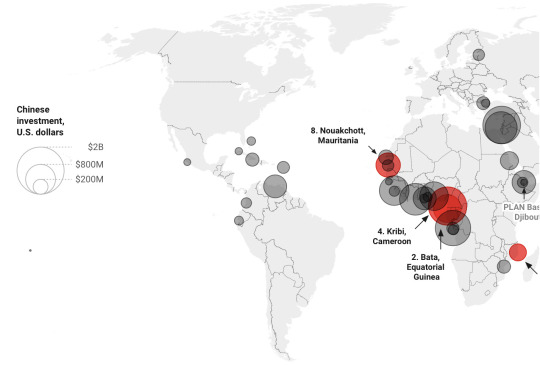
Note: Map excludes pledged funding and canceled or suspended projects. Russia’s port of Sabetta (the Yamal liquefied natural gas project) is also excluded. It has received an estimated $14.9 billion from China; however, researchers were unable to disaggregate the amount that went solely to the Sabetta seaport. Map By Sarina Patterson/AidData. Source: AidData/William & Mary
Ousting or outflanking the United States in the Western Pacific is a priority for Beijing, as is challenging the United States, India, and the rest of the so-called Quad alliance in the Indian Ocean. And more than half of our shortlist is indeed Indo-Pacific-oriented, as is Djibouti. What’s surprising is the intensity of Chinese investment, including in ports, on the Atlantic side of Africa. Factoring in Chinese port operators, China is more active across a greater number of ports on the Atlantic side of Africa than on the Indian Ocean, where so much geopolitical attention has been focused. China has been building ports from Mauritania southward around West Africa, through the Gulf of Guinea, and to Cameroon, Angola, and Gabon.
A base in West or Central Africa would be a bold play for a navy that is still getting its blue-water legs just 15 years after learning how to operate far from home, in the anti-piracy missions in the Gulf of Aden. Atlantic bases would put the PLAN in relative proximity to Europe, the Strait of Gibraltar, and key trans-Atlantic shipping lanes. And a shift to the Atlantic would be against the run of play. The United States has been obsessed with the Indo-Pacific, inking the AUKUS security partnership with the U.K. and Australia, deepening logistics ties with India, returning to the Philippines and the Solomon Islands, and cooperating on defense with Papua New Guinea. A PLAN base in the Atlantic would wrong-foot the naval calculus of Washington and Brussels, and send planners back to the drawing board.
We also find that China likes to put its ports in out-of-the-way places. One example is Beijing’s heavy investment in the port of Caio, an exclave province of Angola. Sometimes there are simple explanations: a lack of natural harbors of sufficient depth of water, or proximity to natural resources. But according to one shipping executive, Chinese entities in the past have seen their ports exposed to labor strife, public protests, and other disruptions, and so now prefer to distance themselves from these situations. Chinese entities likely prefer secure new locations where they can ensure majority and unfettered control or avoid a host country’s public opinion backlash. These would also be selling points in determining where to locate a naval facility.
More on our top eight most likely PLAN bases, highlighted on the map:
1. Hambantota, Sri Lanka 🇱🇰
China has collectively sunk more than $2 billion dollars into Hambantota—the most of any port anywhere in the world, according to our data set. Beijing exercises direct control over the facility. Coupled with its strategic location, the popularity of China among elites and the population, and Sri Lanka’s alignment with China in U.N. General Assembly voting, Hambantota is our top candidate for a future base.
2. Bata, Equatorial Guinea 🇬🇶
Sources in the U.S. Defense Department raised concerns about Chinese interest in a base at Bata, which were then picked up by mainstream media. The absence of any official statement by Beijing on a base is not necessarily conclusive—there were repeated denials from China about any such intentions for Djibouti, right up until the time an announcement was made that a base was coming. The commercial investment was used as the entree, but within months, construction had begun. Politically, Equatorial Guinea (as well as Cameroon and Togo) are all family dynasties or authoritarian regimes in power for years with succession plans in place or mooted. According to the Economist Intelligence Unit’s Democracy Index in 2022, all three rank toward the very bottom of global democracy rankings: Togo at 130th, Cameroon at 140th and Equatorial Guinea at 158th.
3. Gwadar, Pakistan 🇵🇰
The China-Pakistan relationship is both strategic and economic. Pakistan is the flagship country for China’s big Belt and Road infrastructure gambit, and it’s Beijing’s single largest customer for military exports. In Pakistan, Chinese warships are already a fixture: As it modernizes, Pakistan’s navy has become the largest foreign purchaser of Chinese arms, operating modern Chinese-designed surface warships and submarines. Gwadar itself is strategically situated in the far west of Pakistan, providing cover for the Strait of Hormuz. China is significantly more popular with the Pakistani public than the United States is. Though troubled, Pakistan is a democracy, and so China cannot necessarily permanently count on a leadership friendly to the notion of a naval base. Much could hang on the fate in Pakistan of the massive China-Pakistan Economic Corridor, the belle of the Belt and Road ball, of which Gwadar is a big component. The stakes and scrutiny are high, and success or otherwise of the economic corridor could impact receptiveness to a PLAN base.
4. Kribi, Cameroon 🇨🇲
The Kribi port trails only Hambantota in terms of the size of Chinese investment. It is Bata’s most likely competitor, but the ports are only about 100 miles apart. China would likely only choose one. Cameroon’s U.N. General Assembly voting and overall geopolitical positioning aligns well with China. Elsewhere, Caio in Angola, Freetown in Sierra Leone, and Abidjan in Côte d’Ivoire would all be basing possibilities, based on the size of Beijing’s investments there. Of Sierra Leone’s two main political parties, one (the All People’s Congress) is closely linked to China. At political rallies, its supporters have chanted phrases such as “We are Chinese” and “We are black Chinese.” Beijing has successfully insinuated itself into the political life of the country.
5. Ream, Cambodia 🇰🇭
While the official investment to date has been small, Ream, Cambodia, is very likely to be a PLAN facility in one form or another. While the United States and the West are popular with Cambodians, Prime Minister Hun Sen is a longtime ally of Beijing, and it is he who matters. Although he plans to step down in August to be replaced by his son, he’s expected to continue to call the shots. The elites of Cambodia have done well under Belt and road Initiative and are aligned closely with China. In 2020, Cambodia’s voting in the U.N. General Assembly mirrored that of China and coincided with the United States on just 19 of 100 contested votes that year, a rate only slightly higher than Iran, Cuba, and Syria. Hun Sen denies that Ream will be hosting the PLAN anytime soon, but the evidence indicates otherwise.
6. Luganville, Vanuatu 🇻🇺
Beijing has spent decades trying to crack the first island chain that hems it in. A PLAN base, perhaps not very large, makes sense somewhere in the South or Central Pacific. While our data shows only limited Chinese investments in port infrastructure in the region thus far, Vanuatu is one location where construction has been funded, at Port Luganville on the island of Espiritu Santo. An investment of $97 million is not small, as it puts Vanuatu in the top 30 investments globally, according to our data. And there is precedent: In World War II, the strategically located island was home to one of the largest U.S. Navy advanced bases and repair facilities in the Pacific. The Canal du Segond in front of Luganville was a massive, sheltered anchorage, home to fleets, floating dry docks, an air base, and supply bases.
7. Nacala, Mozambique 🇲🇿
While China’s port investments in Mozambique have not been on the same scale as in other locations, neither have they been insignificant. Mozambique also has not seen the backlash to Chinese loans and investments witnessed in other countries in East and Southern Africa, such as Kenya and Tanzania. China is popular with elites and the general population, and it sponsors a significant amount of the country’s media content. The question is: Where to site a base? Maputo is the largest port, but it is run by the government and Dubai Ports World. China has funded construction or expansion in both Beira and Nacala—both ports make our top 20 in terms of investment totals. Beira is likely too shallow for large warships, as it requires regular dredging. Nacala would make the most sense—it has seen sizable Chinese investment and is a deep-water port.
8. Nouakchott, Mauritania 🇲🇷
Mauritania is removed from the logjam of PLAN options in West and Central Africa; Nouakchott is more than 2,000 miles northwest of Bata, for example. The West African nation is also significantly closer to Europe and chokepoints such as the Strait of Gibraltar—roughly only two days’ steaming at 20 knots. At the 2020 U.N. Human Rights Council hearing on China’s new security law for Hong Kong, 53 countries supported China, including Antigua and Barbuda, Cambodia, Cameroon, Equatorial Guinea, Mozambique, Pakistan, Sierra Leone, Sri Lanka—and Mauritania.
Wild Card: Russia 🇷🇺?
While China has been spending loads in the developing world, it could still try for a base in the nearly developed world, by co-locating fleet units at one or more Russian navy bases. There is a clear upside from the Chinese perspective: It doesn’t have to persuade the Russian leadership that the United States and Europe are a threat, and there’s little danger of any U.S. charm offensive to lure Russia away.
Russia has naval bases across its vast land mass, many of which are Cold War legacies. What could be attractive to PLAN naval planners would be a base in the North Pacific Ocean. Such a facility—say, the existing Russian base at Vilyuchinsk on the Kamchatka Peninsula—would be secure, distant from public scrutiny, make use of existing warship docking and repair facilities, and have the merit of placing the PLAN between Japan, a U.S. ally, and Alaska. In both 2021 and 2022, the PLAN and the Russian Navy conducted extensive joint exercises in the East China Sea and western Pacific, including circumnavigating the Japanese main islands. China could also share facilities with the Russian Navy in the Barents Sea, located off the northern coasts of Norway and Russia, or Kola Bay, a natural harbor off the Barents Sea, providing it access to the North Atlantic.
— Rory Fedorochko and Sarina Patterson contributed to this report — Alexander Wooley is a Journalist and Former Officer in the British Royal Navy.
— Sheng Zhang is a Research Analyst with AidData's Chinese Development Finance Program, where he tracks underreported financial flows and leads geospatial data collection. He is the co-author of a previous AidData report on China’s global development footprint, Banking on the Belt and Road.
#Infographic#China 🇨🇳#Naval Bases#Top Destinations#AidData#United States 🇺🇸#India 🇮🇳#Quad Alliance#Indo-Pacific-Oriented#Djibouti 🇩🇯#Mauritania 🇲🇷#Gulf of Guinea 🇬🇳#Angola 🇦🇴#Cameroon 🇨🇲#Gabon 🇬🇦
0 notes
Photo

ANGOLA #angola #angola🇦🇴 #angolawedding #angolafashion (at Cape Town, South Africa) https://www.instagram.com/p/CpN1F4Ctiju/?igshid=NGJjMDIxMWI=
0 notes
Photo

O futuro já começou... Sejam bem vindos, rumo a 2027... #OFuturoJáComeçou #foco #acj2023 #FPU #quemcalaconsente #unitacuanzasul🇦🇴🇦🇴🟥🟩👈🎯 (em NC Consultoria Jurídica & Contabilística, Lda.) https://www.instagram.com/p/CnUxWY5oh0G/?igshid=NGJjMDIxMWI=
0 notes
Text

Angolan Miku 🇦🇴 #miku #brazilianmiku by ToonyNobody
512 notes
·
View notes
Text




Russia 🇷🇺 + Angola 🇦🇴
#russia against racism#russian mother#russian girl#russian wife#russia#🇦🇴❤️🇷🇺#angola#angolan man#angolan husband#white girl kissing#white mother#interracial kissing#mixed family#mixed babies#love has no color#fighting racism#blacklivesmatter#african immigrants welcome
31 notes
·
View notes
Text
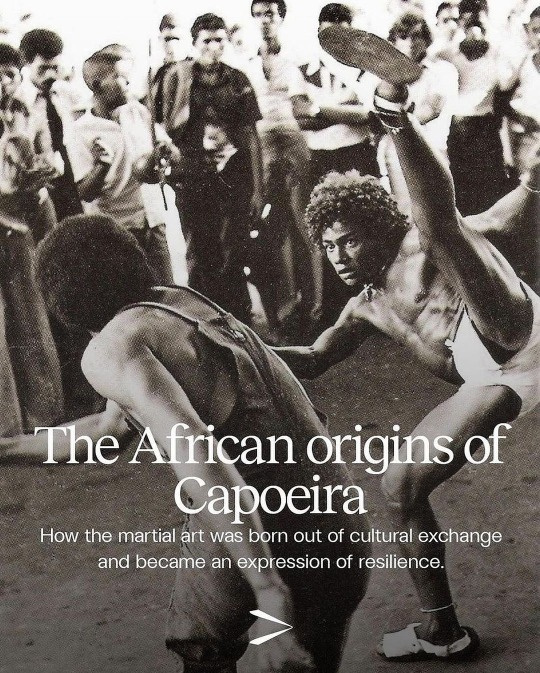
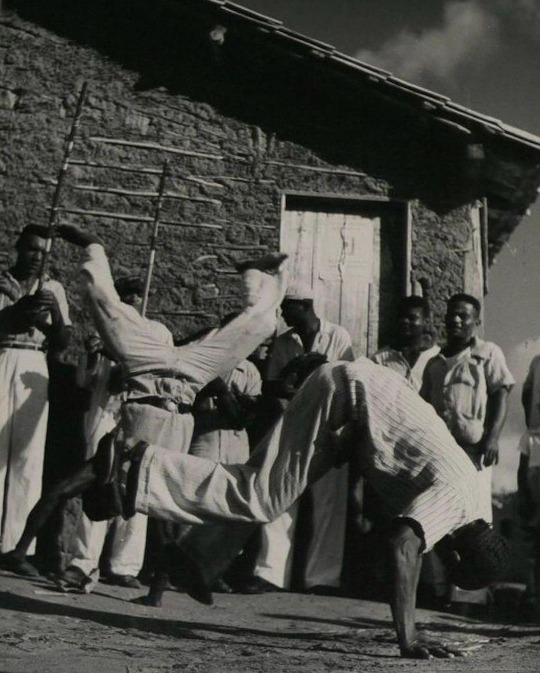
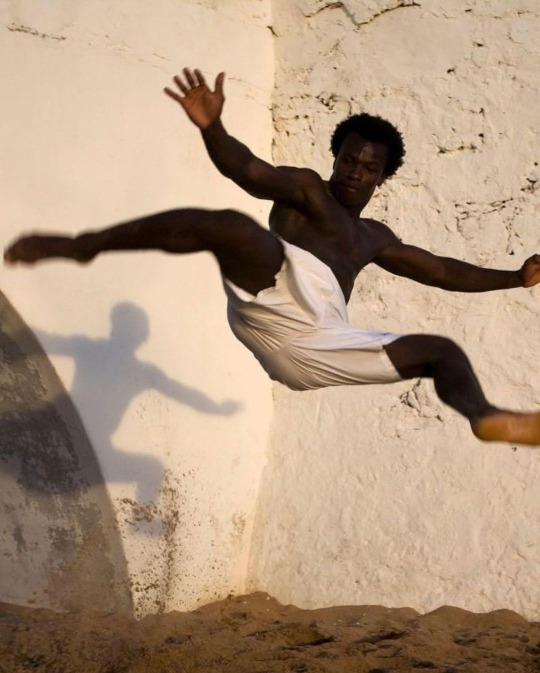

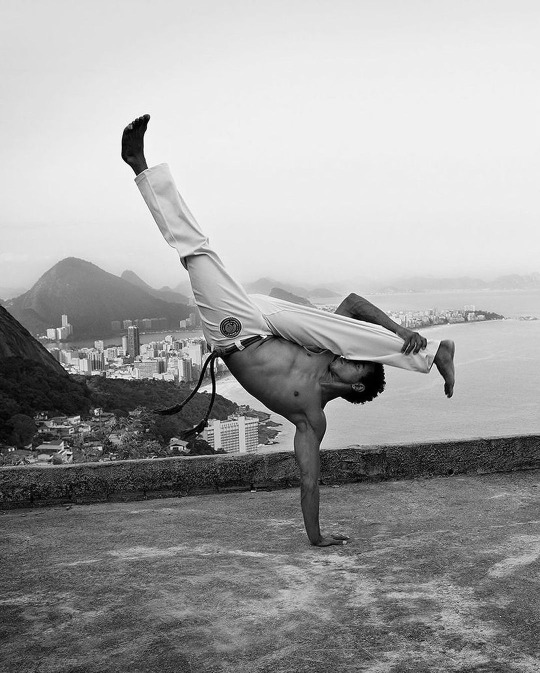
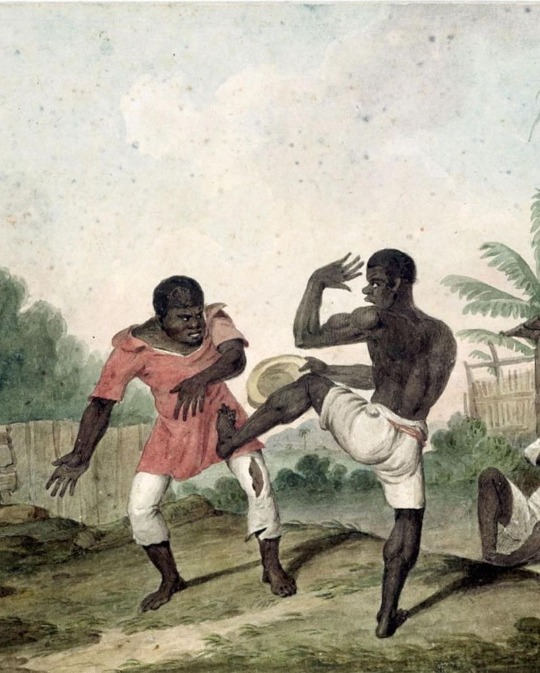
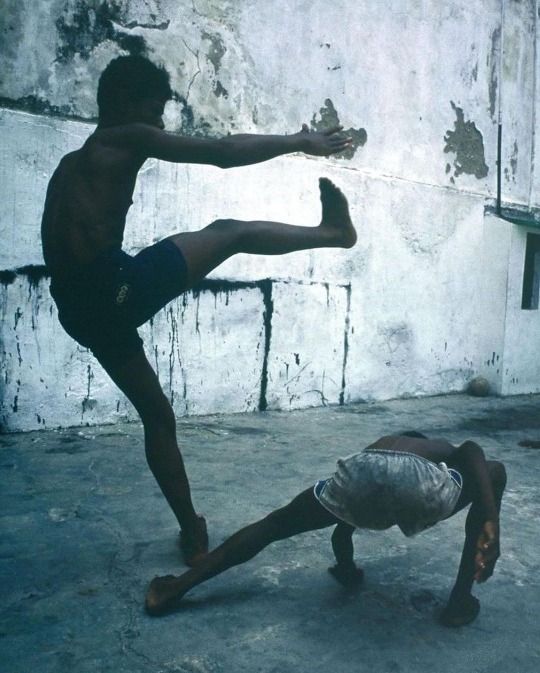
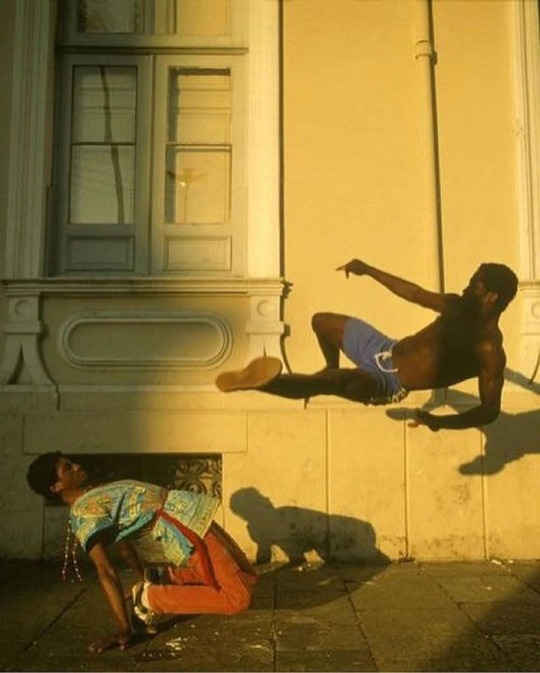
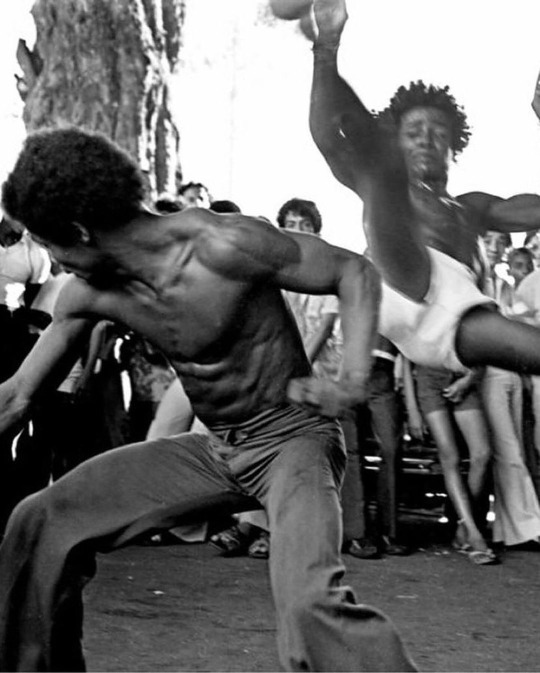

Repost from @moyoafrika
•
#repost• @whatsculture History Class: Tracing the roots of Capoeira. The Afro-Brazilian martial art form incorporates acrobatics, dance, folklore, and music. Two opponents play each other inside a circle (Roda) formed by the other players, who create rhythm for the game by clapping, singing, and playing traditional instruments. It’s the second most popular sport in Brazil and is practiced in different parts of the world today. To understand the significance, we look at how it is a phenomenon born out of migration.
“Capoeira was conceived in Africa and born in Brazil,’’ Mestre Jelon Vieira once said. As a colony of the Portuguese Crown, millions of Africans were shipped and sold in Brazil. There, enslaved Africans shared their cultural traditions, including dances, rituals, and fighting techniques, which eventually evolved into capoeira. Many elements and traditions that would inform capoeira are said to have originated in Angola. At that time, 80% of all enslaved Africans in Rio de Janeiro came from Central West Africa from countries that are now known as Gabon, Angola and both Congos.
People from Angola were prominent among the enslaved Africans who played the game on the streets and squares of Rio de Janeiro, Salvador and other Brazilian port cities at the beginning of the nineteenth century. With many enslaved Africans revolting against slavery, they would soon form communities in villages called quilombos in which they could sustain different expressions of African culture. They used capoeira to defend themselves and resist capture, disguising its martial intent with music, song, and dance.
Capoeira became illegal after the abolition of slavery in 1888. Practitioners were socially ostracised for more 40 years, until the legendary capoeira master, Mestre Bimba, opened the first capoeira school in Bahia in 1932. From there, the martial art would reach all parts of the world. At its core, capoeira is born out of a mix of African and Brazilian indigenous cultures and it represents resistance and resilience 🇧🇷🌍
#moyoafrika #brazil #angola🇦🇴 #africanculture #africanculture #africandiaspora #african
#african#afrakan#kemetic dreams#africans#brownskin#brown skin#afrakans#african culture#afrakan spirituality#capoeira#Brazilian#kids#koda#breakdancing
871 notes
·
View notes
Text







♡̼͓ °̩̥˚̩̩̥͙°̩̥ ♡̼͓ °̩̥˚̩̩̥͙°̩̥ yaqha jaqichasïwiru sarañäni ᓭི༏ᓯྀ ˖ ݁ᓭི༏ᓯྀ ˖ ݁
甘味 🐄🥃🪲 ·*̩̩͙˚̩̥̩̥*̩̩̥͙𓏲ִ ꯭ֻUma montanha russa ꫶ࣺ᭮᭰ 🏋🏿♂️🦅🇦🇴❀



#ེ̥ெ 🎳🚦🪆 𝜗𝜚 短裤紧贴大腿 ❀ ིུ͠ㅤ꯳⃘꤫⃛͡ㅤ⬮ ֵ๋̾͒۫ Uuhuuuu ☆w☆#᭔᭄🔩📿 ૮⍝• ᴥ •⍝ა 143 直到世界终结 ☠️⛰️؞ؖ ᨯ𓂂𓏸#20͟0͟³ あなたと出会った年 🗡️ ༒৯#cupcek:3#moodboard#cravity moodboard#cravity imagines#ugly moodboard#messy moodboard#messycore#icons vintage#vintage moodboard#edgy moodboard#edgy grunge#grunge messy moodboard#grunge moodboard#kpop moodbard#gg moodboard#newjeans hyein#hyein moodboard#anime icons#aesthetic moodboard#kpop aesthetic#random mb#random messy moodboard#y2k moodboard#goth moodboard#archive moodboard#visual archive#archive mb
405 notes
·
View notes
Text
HERE is the list of the 134 countries that are NOT supporting South Africa's 🇿🇦 claims of genocide against Israel 🇮🇱:
🇦🇩 Andorra
🇦🇴 Angola
🇦🇬 Antigua and Barbuda
🇦🇷 Argentina
🇦🇲 Armenia
🇦🇺 Australia
🇦🇹 Austria
🇧🇸 Bahamas
🇧🇧 Barbados
🇧🇾 Belarus
🇧🇿 Belize
🇧🇹 Bhutan
🇧🇦 Bosnia and Herzegovina
🇧🇼 Botswana
🇧🇬 Bulgaria
🇧🇮 Burundi
🇨🇻 Cabo Verde
🇰🇭 Cambodia
🇨🇦 Canada
🇨🇫 Central African Republic
🇨🇱 Chile
🇨🇳 China
🇰🇲 Comoros
🇨🇬 Congo
🇨🇷 Costa Rica
🇭🇷 Croatia
🇨🇺 Cuba
🇨🇾 Cyprus
🇨🇿 Czech Republic
🇨🇩 Democratic Republic of the Congo
🇩🇰 Denmark
🇩🇲 Dominica
🇩🇴 Dominican Republic
🇹🇱 East Timor (Timor-Leste)
🇪🇨 Ecuador
🇸🇻 El Salvador
🇬🇶 Equatorial Guinea
🇪🇷 Eritrea
🇪🇪 Estonia
🇸🇿 Eswatini
🇪🇹 Ethiopia
🇫🇯 Fiji
🇫🇮 Finland
🇫🇷 France
🇬🇪 Georgia
🇩🇪 Germany
🇬🇭 Ghana
🇬🇷 Greece
🇬🇩 Grenada
🇬🇹 Guatemala
🇭🇹 Haiti
🇭🇳 Honduras
🇭🇺 Hungary
🇮🇸 Iceland
🇮🇳 India
🇮🇪 Ireland
🇮🇹 Italy
🇯🇲 Jamaica
🇯🇵 Japan
🇰🇪 Kenya
🇰🇮 Kiribati
🇰🇵 Korea, North (North Korea)
🇰🇷 Korea, South (South Korea)
🇽🇰 Kosovo
🇱🇦 Laos
🇱🇻 Latvia
🇱🇸 Lesotho
🇱🇷 Liberia
🇱🇮 Liechtenstein
🇱🇹 Lithuania
🇱🇺 Luxembourg
🇲🇬 Madagascar
🇲🇼 Malawi
🇲🇹 Malta
🇲🇭 Marshall Islands
🇲🇺 Mauritius
🇲🇽 Mexico
🇫🇲 Micronesia
🇲🇩 Moldova
🇲🇨 Monaco
🇲🇳 Mongolia
🇲🇪 Montenegro
🇲🇲 Myanmar (Burma)
🇳🇷 Nauru
🇳🇵 Nepal
🇳🇱 Netherlands
🇳🇿 New Zealand
🇳🇮 Nicaragua
🇲🇰 North Macedonia (Macedonia)
🇳🇴 Norway
🇵🇼 Palau
🇵🇦 Panama
🇵🇬 Papua New Guinea
🇵🇾 Paraguay
🇵🇪 Peru
🇵🇭 Philippines
🇵🇱 Poland
🇵🇹 Portugal
🇷🇴 Romania
🇷🇺 Russia
🇷🇼 Rwanda
🇰🇳 Saint Kitts and Nevis
🇱🇨 Saint Lucia
🇻🇨 Saint Vincent and the Grenadines
🇼🇸 Samoa
🇸🇲 San Marino
🇸🇹 Sao Tome and Principe
🇷🇸 Serbia
🇸🇨 Seychelles
🇸🇱 Sierra Leone
🇸🇬 Singapore
🇸🇰 Slovakia
🇸🇮 Slovenia
🇸🇧 Solomon Islands
🇪🇸 Spain
🇱🇰 Sri Lanka
🇸🇪 Sweden
🇨🇭 Switzerland
🇹🇼 Taiwan
🇹🇿 Tanzania
🇹🇭 Thailand
🇹🇴 Tonga
🇹🇹 Trinidad and Tobago
🇹🇳 Tunisia
🇹🇲 Turkmenistan
🇹🇻 Tuvalu
🇺🇦 Ukraine
🇬🇧 United Kingdom (UK)
🇺🇸 United States of America (USA)
🇺🇾 Uruguay
🇻🇺 Vanuatu
🇻🇦 Vatican City
🇻🇳 Vietnam
🇿🇲 Zambia
🇿🇼 Zimbabwe
449 notes
·
View notes
Text

These are African countries with their capital:
1. Algeria - Algiers 🇩🇿
2. Angola - Luanda 🇦🇴
3. Benin - Porto-Novo 🇧🇯
4. Botswana - Gaborone 🇧🇼
5. Burkina Faso - Ouagadougou 🇧🇫
6. Burundi - Bujumbura 🇧🇮
7. Cabo Verde - Praia 🇨🇻
8. Cameroon - Yaoundé 🇨🇲
9. Central African Republic - Bangui 🇨🇫
10. Chad - N'Djamena 🇹🇩
11. Comoros - Moroni 🇰🇲
12. Democratic Republic of the Congo - Kinshasa 🇨🇩
13. Djibouti - Djibouti 🇩🇯
14. Egypt - Cairo 🇪🇬
15. Equatorial Guinea - Malabo 🇬🇶
16. Eritrea - Asmara 🇪🇷
17. Eswatini - Mbabane 🇸🇿
18. Ethiopia - Addis Ababa 🇪🇹
19. Gabon - Libreville 🇬🇦
20. The Gambia - Banjul 🇬🇲
21. Ghana - Accra 🇬🇭
22. Guinea - Conakry 🇬🇳
23. Guinea-Bissau - Bissau 🇬🇼
24. Ivory Coast - Yamoussoukro 🇨🇮
25. Kenya - Nairobi 🇰🇪
26. Lesotho - Maseru 🇱🇸
27. Liberia - Monrovia 🇱🇷
28. Libya - Tripoli 🇱🇾
29. Madagascar - Antananarivo 🇲🇬
30. Malawi - Lilongwe 🇲🇼
31. Mali - Bamako 🇲🇱
32. Mauritania - Nouakchott 🇲🇷
33. Mauritius - Port Louis 🇲🇺
34. Morocco - Rabat 🇲🇦
35. Mozambique - Maputo 🇲🇿
36. Namibia - Windhoek 🇳🇦
37. Niger - Niamey 🇳🇪
38. Nigeria - Abuja 🇳🇬
39. Rwanda - Kigali 🇷🇼
40. Sao Tome and Principe - Sao Tome 🇸🇹
41. Senegal - Dakar 🇸🇳
42. Seychelles - Victoria 🇸🇨
43. Sierra Leone - Freetown 🇸🇱
44. Somalia - Mogadishu 🇸🇴
45. South Africa - Pretoria (administrative), Bloemfontein (judicial), Cape Town (legislative) 🇿🇦
46. South Sudan - Juba 🇸🇸
47. Sudan - Khartoum 🇸🇩
48. Tanzania - Dodoma 🇹🇿
49. Togo - Lome 🇹🇬
50. Tunisia - Tunis 🇹🇳
51. Uganda - Kampala 🇺🇬
52. Zambia - Lusaka 🇿🇲
53. Zimbabwe - Harare 🇿🇼
54. Congo Brazaville :Brazaville
109 notes
·
View notes

